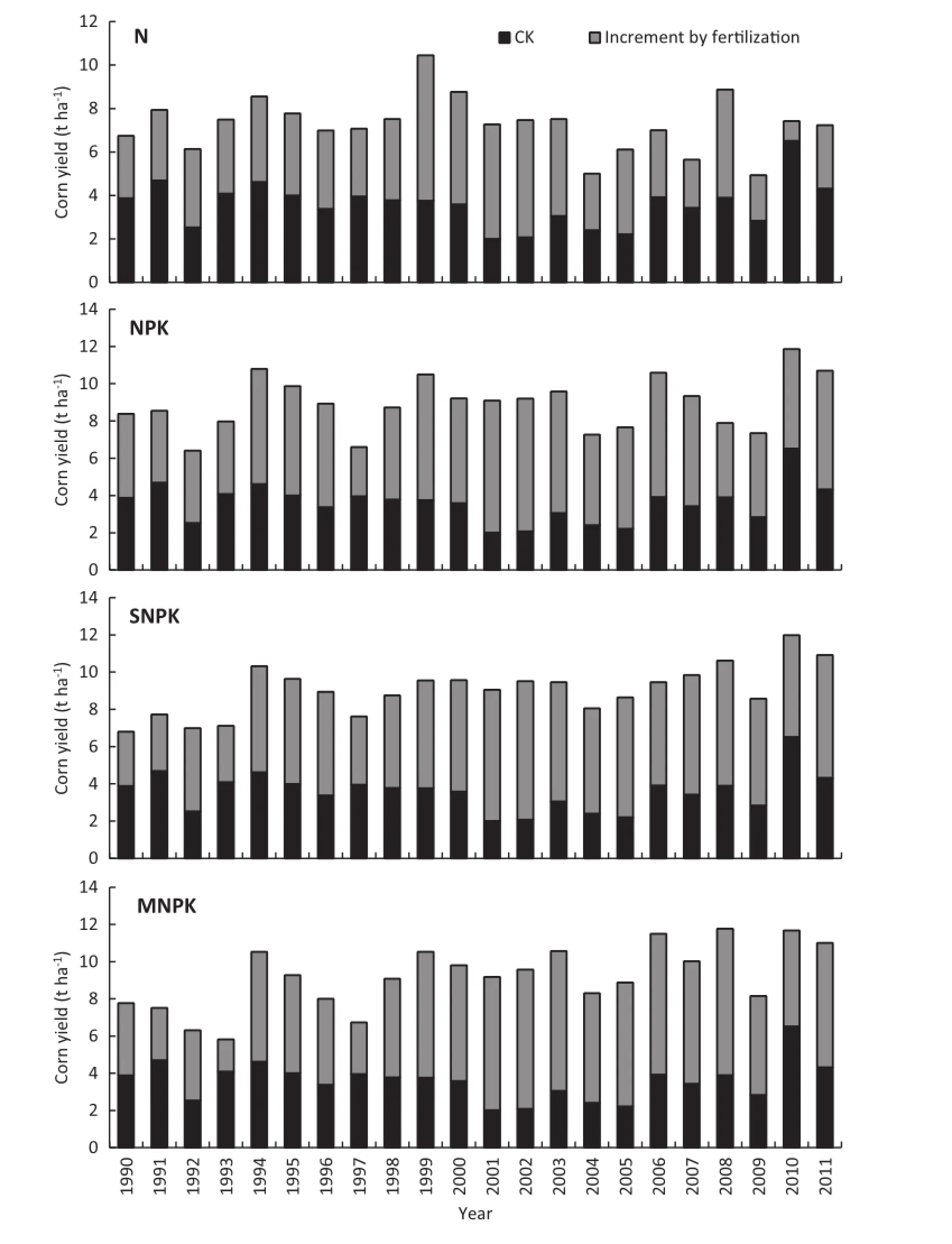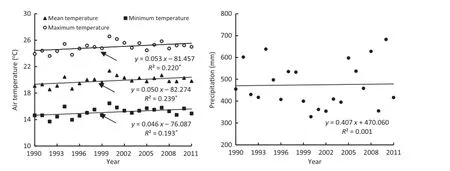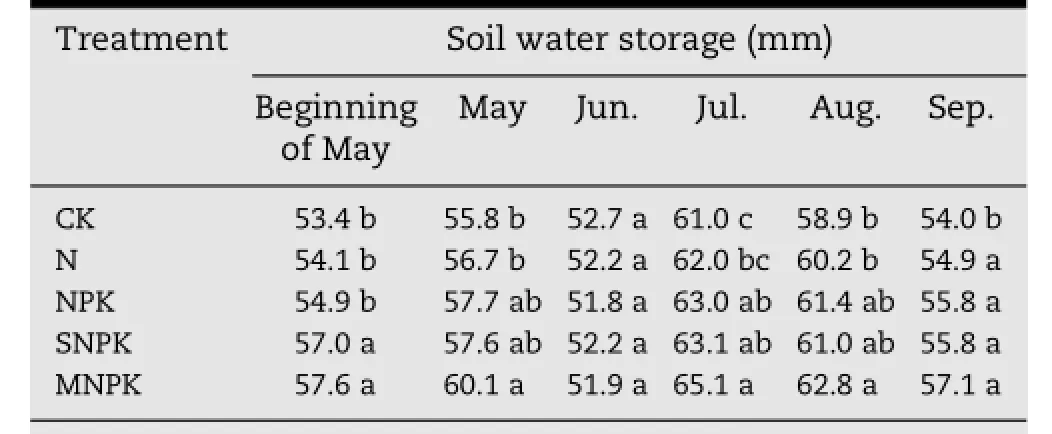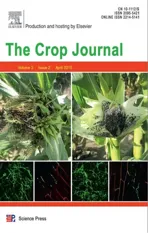Organic amendments increase corn yield by enhancing soil resilience to climate change
2015-11-12ZhenweiSongHongjunGoPingZhuChngPengAixingDengChengynZhengMdAdulMnnfMdNurulIslmWeijinZhng
Zhenwei Song,Hongjun Go,Ping Zhu,Chng Peng,Aixing Deng,Chengyn Zheng,Md Adul Mnnf,Md Nurul Islm,Weijin Zhng,*
aInstitute of Crop Sciences,Chinese Academy of Agricultural Sciences/Key Laboratory of Crop Physiology and Ecology,Ministry of Agriculture,Beijing 100081,China
bJilin Academy of Agricultural Sciences,Changchun 130124,China
cBangladesh Agricultural Research Institute,Joydebpur,Gazipur 1701,Bangladesh
Organic amendments increase corn yield by enhancing soil resilience to climate change
Zhenwei Songa,1,Hongjun Gaob,1,Ping Zhub,Chang Pengb,Aixing Denga,Chengyan Zhenga,Md Abdul Mannafc,Md Nurul Islamc,Weijian Zhanga,*
aInstitute of Crop Sciences,Chinese Academy of Agricultural Sciences/Key Laboratory of Crop Physiology and Ecology,Ministry of Agriculture,Beijing 100081,China
bJilin Academy of Agricultural Sciences,Changchun 130124,China
cBangladesh Agricultural Research Institute,Joydebpur,Gazipur 1701,Bangladesh
A R T I C L E I N F O
Article history:
2 January 2015
Accepted 16 February 2015
Available online 23 February 2015
Long-term fertilization Maize cropping
Soil quality
Global warming
Northeast China
A 22-year field experiment was conducted in Gongzhuling,Jilin province,China to investigate corn yield response to fertilization practice.Compared to an unfertilized control(CK),all fertilization treatments,including inorganic nitrogen fertilizer only(N),balanced inorganic fertilizers(NPK),NPK plus corn straw(SNPK),and NPK plus farmyard manure(MNPK),resulted in significant increases in corn yield.However,only organic matter amendments sustained increasing yield trends,with annual rates of 0.137 and 0.194 t ha-1for the SPNK and MNPK treatments,respectively(P<0.05).During the 22 years,the daily mean,maximum and minimum temperatures increased by 0.50,0.53,and 0.46°C per decade,whereas precipitation displayed no significant change but showed large seasonal variation.According to a regression analysis,increased air temperature exerted positive effects on corn yields under the SNPK and the MNPK treatments.Under both treatments,soil organic carbon contents and soil nutrient availabilities increased significantly compared to their initial levels in 1990,whereas soil bulk density and total porosity changed slightly under the two treatments,which showed higher soil water storage than other treatments.In contrast,significant increases in soil bulk density and decreases in soil total porosity and soil nutrient availability were observed under the CK,N and NPK treatments.The contributions of soil fertility to corn yield were 28.4%,37.9%,38.4%,39.0%,and 42.9%under CK,N,NPK,SNPK,and MNPK treatments,respectively,whereas climate changes accounted for 27.0%,14.6%,12.4%,11.8%,and 10.8%.These results indicate that,in Northeast China,organic matter amendments can mitigate negative and exploit positive effects of climate change on crop production by enhancing soil quality.
©2015 Crop Science Society of China and Institute of Crop Science,CAAS.Production and hosting by Elsevier B.V.This is an open access article under the CC BY-NC-ND license
(http://creativecommons.org/licenses/by-nc-nd/4.0/).
1.Introduction
Fertilizer application plays an important role in soil quality improvement and crop productivity enhancement[1,2].Sound fertilization can directly increase crop yield by improving soil nutrient availability and can indirectly enhance crop yield sustainability by improving soil physical and chemical resilience to climate variation[3].However,long-term application of inorganic fertilizers,especially unbalanced chemical fertilization,may result in soil acidification and nutrient depletion[4,5]. Consequently,poor fertilization practice may intensify climate change impacts on crop production,especially in high-latitude areas[6].Organic matter amendments,for example green manuring and crop straw return,have been widely recommended as practices enhancing crop yield while increasing soil quality[1,7,8].However,some field studies have not found significant effects of manure application and straw return on soil quality[9,10].Themainreasonsforuncertaintyaboutfertilizationeffects maybeshortexperimentalperiods,giventhatfertilizationeffects on soil quality occur on a long-term time scale[10,11].Thus,long-termfieldexperimentscanassistinguidingtheassessment of fertilization effects and innovations in agronomic techniques[12-14].Furthermore,high-latitude areas have experienced and will continue to face the largest changes in air temperature and precipitation[6],so that it is necessary and urgent to design fertilization practices for sustainable crop production in these areas.
Northeast China,a typical cool,high-latitude rainfed cropping region,is one of the most important grain cropping regions in China[15].During the past decades,intensive cropping of monoculture corn and poor fertilization practices have resulted in severe soil quality degradation and corn yield decline in the region [16,17].Although great efforts have been made in the assessment of fertilization effects on crop yield and soil quality in the region,few have focused on relationships between crop yields and climatic factors under different fertilizer regimes[16-19].Fortunately,there is a novel experiment using different fertilization regimes(chemical fertilizer only,unbalanced fertilization,farmyard manure,and crop straw residue)in Gongzhuling,Jilin province,China.This experiment has been conducted with a continuous corn cropping system since 1989 and accordingly offers a chance to assess the long-term impacts of fertilization on corn yield and soil quality,and the consequent effects on soil resilience to climate change.We conducted an integrated study of historical variation in crop yield and climate factors and of changes in soil quality.Our objective was to identify the mechanism underlying fertilization effects on corn yield and soil resilience to air temperature and precipitation changes in a high-latitude area.
2.Materials and methods
2.1.Experimental site
A long-term fertilization experiment with monoculture corn under rainfed conditions has been conducted since 1990.The experiment site is located at the National Long-term Location Monitoring Base on Black Soil Fertility and Fertilizer Efficiency,Gongzhuling(43°30′23″N,124°48′34″E,220 m above sea level),Jilin province,China.This site is in the northern temperature zone with a continental monsoon climate,which is cold and arid in winter and hot and rainy in summer.Annual precipitation is 562 mm,with almost 80%occurring from June to September,and annual average temperature and sunshine duration are 5.6°C and 2710 h,respectively.The soil is classified as Haplic Phaeozem in the FAO-Unesco system and Cumulic Hapludoll(Mollisol)in the U.S.classification system [20].The soil properties prior to the experiment had the following characteristics:pH 7.6,soil organic carbon(SOC)12.7 g kg-1,total nitrogen(TN)1.4 g kg-1,total phosphorus(TP)0.61 g kg-1,total potassium(TK)18.4 g kg-1,available nitrogen(AN)114.0 mg kg-1,availablephosphorus(AP)11.8 mg kg-1,andavailable potassium(AK)158.3 mg kg-1.Corn had been cultivated in the experimental field for at least 50 years before 1990.
2.2.Experimental design and management
A randomized complete block design was used with three replicates in this long-term experiment.The experiment included five treatments:(1)unfertilized control(CK),(2)inorganic nitrogen fertilizer only at a rate of 165 kg N ha-1(N),(3)balancedinorganicfertilizersat165 kg N ha-1,82.5 kg P2O5ha-1,and 82.5 kg K2O ha-1(NPK),(4)balanced inorganic fertilizers at 112 kg N ha-1,82.5 kg P2O5ha-1,and 82.5 K2O kg ha-1plus corn straw residue at a rate of 7.5×103kg ha-1(SNPK),and(5)balanced inorganic fertilizers at 50 kg N ha-1,82.5 kg P2O5ha-1,and 82.5 kg K2O ha-1plus farmyard manure at a rate of 2.3×104kg ha-1(MNPK). The N contents in corn straw and farmyard manure were 7.0 and 5.0 g kg-1,respectively.For this reason,the total N application rates for N,NPK,SNPK,and MNPK treatments were kept at 165 kg ha-1.The C:N ratios of maize straw residue and farmyard manure in dry matter were 66:1 and 26:1,respectively.
Each replicate plot was 130 m2in size.Four corn hybrids: Danyu 13,Jidan 222,Jidan 209,and Zhengdan 958,were used over the experimental period.Seeds were sown in early May at a density of 5.05×104plants ha-1with a spacing of 60 cm×33 cm.Seeding was done manually on the ridge in 5-cm depth of soil after land preparation followed by basal fertilizer application.The sources of inorganic N,P,and K fertilizers were urea,triple superphosphate(TSP)and muriate of potash(MoP).One third of the urea and the full amounts of TSP and MoP were applied as a basal dose.The remaining two thirds of the urea was used for side dressing at the corn jointing(V6)stage and the chopped corn straw was also applied at that time in the SNPK plots each year. The farmyard manure was applied in autumn after corn harvesting in the MNPK plots every year.Tillage operations included(1)removing aboveground biomass manually,incorporating stubble and main roots into the soils by rototiller,and leveling the field after harvest in autumn;(2)cultivating again and building ridges to 20 cm height before planting in spring;and(3)rebuilding the ridge twice at approximately 20-day intervals after planting.The landwas kept weed-free and plant-protection measures were taken when required.
2.3.Soil sampling and analysis
Volumetric soil water content at 0-20 cm depth was measured using a Hydrosense soil moisture meter(Campbell Scientific,Inc.,USA).Six locations were selected randomly in each plot.The 20-cm length probe was inserted into the soil perpendicularly in the ridge and readings were recorded.The measurements were taken at the beginning of May and in mid-May,June,July,August,and September during 2010 and 2011.The Hydrosense meter was calibrated each year by measurement of the meter responses at saturation soil and at completely dried soil.
Soil temperatures were continuously recorded using model ZDR41 data loggers(Zeda Instruments,Co.,Ltd,Hangzhou,China)integrated with external soil temperature thermocouples.Two soil temperature thermocouples were placed in a row at 5 cm and 15 cm soil depth in each plot. The soil temperatures were measured every half hour throughout the growing season.The soil temperatures for both two soil depths were then converted into mean monthly data at 0-20 cm depth.
Soil samples at the depth of 0-20 cm were collected by the core method after corn harvesting in October 2011.Six random cores were collected from the field to combine into one composite sample for each plot.The entire volume of soil was mixed thoroughly,air-dried,and passed through an 8-mm sieve.SOC,TN,TP,TK,AN,AP,AK,and pH in soil samples were determined.All methods are described in detail by Lu[21].
Soil bulk density(SBD)was determined on an oven-dry basis using the core method[22].Six soil cores were taken randomly in the ridge at 5-15 cm soil depth for each plot. Then undisturbed soil samples(100 cm3cylinders)were obtained to measure the soil bulk density.Soil total porosity(STP)was calculated as

where SBD was soil bulk density,and PD was the soil particle density,assumed to be 2.65 g cm-3[23].
Corn yields were determined by manually harvesting each plot annually.Grain samples were air-dried on the ground by threshing until reaching a uniform moisture level of 14% water content,and then weighed.
2.4.Climate data collection
Historical climate data from May to September over the period 1989-2011 were recorded by an automatic climate station located 1 km from the experimental field.The meteorological data included daily temperatures and daily precipitation.
2.5.Data analysis
Means of long-term yield and yield increment by fertilization were used to evaluate fertilization effects on corn yield. The yield increment by fertilization was calculated as the difference between fertilized treatment and CK treatment[8,24].Because according to Hafner[25],linear growth in cereal yields has been the most common trend over time in terms of global harvest and production area,time trends in corn yield were evaluated by linear regression analysis.The time trends in weather parameters were also evaluated by linear regression analysis[13].The yield increment by fertilization trend was better fitted by a curvilinear equation in the present study.The relationship between corn yields and climate parameters were calculated using Pearson correlation coefficients[26].The SPSS 13.0 package(SPSS Inc.,USA)was used for statistical analysis.The effects of treatments on corn yields,soil properties,and soil water storage were assessed by one-way ANOVA using least significant differences(LSD)at the 0.05 probability level. The contributions of climate and soil changes to corn yield under different fertilization regimes were calculated using a general linear model(GLM)in SAS 9.2(SAS Institute Inc.,USA).
3.Results
3.1.Changes in corn yields
All fertilization practices increased corn yield significantly(Fig.1 and Table 1).During 1990-2011,the mean corn yields under the N,NPK,SNPK,and MNPK treatments were 7.27,9.03,9.05,and 9.18 t ha-1,respectively,which were significantly higher than that under the CK treatment(P<0.05). Corn yields under the NPK,SNPK,and MNPK treatments were significantly higher than that under the N treatment. Although no significant differences were observed among the NPK,SNPK,and MNPK treatments,the corn yields under the SNPK and MNPK treatments showed significant annually increasing trends,with rates of 0.137 and 0.194 t ha-1,respectively.The yield increment by fertilization reflects the effects of fertilizer on corn yield.For the past 22 years,the mean yield increment by fertilization was significantly greater in the SNPK and MNPK than under the NPK and N treatments.The trends of yield increment with the year were related by a second-order function.The yield increment by fertilization increased at the beginning of the experiment,and decreased afterward for all the treatments.Generally,the increasing trends of the yield increment by fertilization under the N and NPK treatments continued for only 12 and 13 years,while these trends under the SNPK and MNPK treatments continued for 17 and 19 years,respectively.
3.2.Climate changes and relationships with corn yield
Significant warming trends were found during the corn growth period over the 22-year period(Fig.2).The daily mean,maximum and minimum temperatures increased at the rates of 0.50,0.53,and 0.46°C per decade,respectively. Precipitation during the corn growth period displayed no significant change,but showed large annual variation.To identify the effects of climate changes on corn yield,a Pearson correlation analysis between corn yield and yield increment by fertilization and the main climate factors wasperformed(Table 2).Significant correlations were found between corn yield and daily mean and minimum temperatures under the SNPK and MNPK treatments,and between corn yield and precipitation under the CK,N,and NPK treatments.No significant correlation was found between corn yield and air temperature under the CK,N,and NPK treatments.Furthermore,the yield increment by fertilization under SNPK and MNPK showed significant positive correlations with all temperature factors.

Fig.1-Corn yield and yield increments under different fertilization regimes during 1990-2011.CK,unfertilized control;N,inorganic N fertilizer only;NPK,balanced inorganic fertilizers of N,P and K;SNPK,balanced inorganic fertilizers plus corn straw;MNPK,balanced inorganic fertilizers plus farmyard manure.
3.3.Changes in topsoil properties
Fertilization caused significant differences in soil properties between treatments(Table 3).Compared to the initial level,both inorganic fertilizer application and unfertilized treatment increased SBD and decreased STP significantly in the 0-20 cm layer.The SBD were 15.4%,18.8%,and 14.5%higher,and the STP were 12.4%,13.9%,and 11.5%lower under the CK,N and NPK treatments,respectively,than the correspondingvalues in 1990.No significant changes in the SBD and STP were found in the treatments of inorganic fertilizer application plus organic amendments(SNPK and MNPK).The CK,SNPK,and MNPK maintained unchanged soil pH,but N and NPK treatments resulted in soil acidification.There were large(21.3%and 60.6%,respectively)increases in SOC in the treatments of SNPK and MNPK,whereas no significant increments occurred under the CK,N,and NPK treatments during the experimental period.Significantly higher soil nutrient contents were also found under the SNPK and MNPK treatments.Thus,most soil nutrients showed an increasing trend in availability under the SNPK and MNPK treatments compared to their initial levels.In contrast,the CK,N,and NPK treatments generally did not increase soil nutrients over the 22-year period.

Table 1-Annual trends of corn yield and yield increments under different fertilization regimes during 1990-2011.
3.4.Changes in soil water storage and temperature
Soil water storage at 0-20 cm depth under fertilized treatments was generally higher than that under the CK treatment during the entire corn growth period(Table 4).Soil water storage under SNPK and MNPK were significantly higher than those under the N and NPK treatments at the beginning of May.There was no significant difference among the treatments in the monthly soil temperature below 0-20 cm soil depth(Table 5).
3.5.Contributions of climate and soil changes to corn yield
To identify the contributions of climate and soil changes to corn yield under different fertilization regimes,an analysis was performed using a GLM.Fertilization promoted soil stability,as indicated by the contribution of soil factors to corn yield.The contributions of climate changes to corn yield were 27.0%,14.6%,12.4%,11.8%,and 10.8%under the CK,N,NPK,SNPK,and MNPK treatments,respectively,whereas the contributions of soil changes were 28.4%,37.9%,38.4%,39.0%,and 42.9%(Table 1).Unknown factors accounted for a large proportion and may represent scientific and technological progress and agronomic technique improvement.

Fig.2-Annual change trends in daily mean,maximum,and minimum temperatures and precipitation over the corn-growing season during 1990-2011.*Trends significant at the 0.05 probability level.

Table 2-Correlations between corn yield,yield increments,and climate factors under different fertilization regimes over the entire corn growth period during 1990-2011.
4.Discussion
Although all fertilization practices increased corn yield,only the organic amendments,in the form of the MNPK and SNPK treatments,could increase corn yield with an increasing trend(Table 1).Similar results were also reported in north China[27],south China[8],and northwest China[1].These studies suggest that organic amendments can improve crop productivity over the long term.The long-term trend of crop yield change is attributed to the integrated effects of the changes of climate,cultivar,soil quality and agronomic practice[28].It is well known that organic amendments can directly enhance crop growth by improving soil nutrient availability[8],a finding also confirmed in our experiment(Table 3).However,less is known about the resulting impacts on soil resilience to climate change.
In our study,the significant differences in the correlation of cornyieldandclimatefactorsamongthetreatmentsareevidence fortheindirecteffectsoffertilizationonsoilresilience.Duringthe past decades,there have been increases in air temperature,especially daily minimum temperature,and great variation in precipitation in the study area(Fig.2).Many studies have found climate variables such as air temperature and precipitation to be strongly associated with corn yield[29,30].For example, Chen et al.reported that warming benefited corn production in Northeast China[26].Song et al.also found that precipitation variability had a negative effect on corn yield,owing to seasonal drought in the study area[31].In the present study,significant correlations between corn yield and climate factors were found among the treatments after the 22-year fertilization experiment(Table 2).The significant positive correlation between corn yield and air temperature under the SNPK and MNPK treatments indicate that the organic matter amendments helped corn to exploit the positive effects of warming.This finding suggests that organic amendments enhanced soil resilience to air temperature increase.However,there was no significant correlation between corn yield and air temperature in the CK,N,and NPK treatments,suggesting that these fertilization practices did not help corn exploit the positive effects of warming,nor was there significant correlation between corn yield and precipitation under the SNPK and MNPK,indicating that organicamendmentshaveimprovedsoilresilienceto precipitation variation.This inference is confirmed by the higher soil water storage under the SNPK and MNPK than that under the CK,N,and NPK treatments(Table 4).In contrast,a significant correlation was found between corn yield and precipitation under the CK,N,and NPK treatments,indicating that soil moisture limited corn growth in thepoorly fertilized plots.Thus,our study indicates that organic amendments can mitigate the negative and promote the positive effects of climate changes on corn production in Northeast China.

Table 3-Topsoil(0-20 cm)properties as affected by long-term fertilization in different treatments.

Table 4-Average soil water storage at 0-20 cm depth under different fertilization treatments during 2010 and 2011.
The mechanisms underlying the enhancement of soil resilience can be attributed to the improvement of soil quality caused by organic amendments[1,8].Long-term organic matter inputs into the soil can directly increase SOC,content as confirmed by the significant increases in SOC under the SNPK and MNPK treatments(Table 3).Similar increases in SOC caused by crop straw return and manure application have also been reported by previous studies[1,7,8].The increment in SOC content can stimulate soil microbial biomass growth and population diversity increase[32,33].In this manner,organic amendments can improve soil quality by promoting soil aggregation,because SOC and soil microbes are the major agents of soil aggregate formation[34].Increases in SOC can also decrease soil bulk density,resulting in higher soil porosity,as also confirmed in our study(Table 3).The lower bulk density and higher porosity help crop root growth and water storage in deep soil layers[35].As a result,the improved physical and chemical qualitycan enhance soil resilience to air temperature elevation and precipitation variation[36].The contributions of climate and soil change to corn yield also confirmed that the application of organic amendments could promote soil stability and minimize the effect of climate change(Table 6).Finally,significantly higher yields with increasing trends were found in the organic amendment fields than in the others.Climate change occurs over a long term,whereas the present study was limited to a 22-year experiment.Fertilizer effects on soil resilience await further investigation.

Table 5-Average soil temperature at 0-20 cm depth under different fertilization regimes during 2010 and 2011.

Table 6-Contributions of climate and soil changes to corn yield under different fertilization regimes.
5.Conclusions
Organic matter amendments,such as farmyard manure and crop straw,cannot only increase corn yield but also maintain a sustainable increasing trend in corn yield,owing to the enhancement of soil fertility and resilience to climate changes.Unbalanced fertilization can also increase corn yield,but it cannot sustain a high yield for a long term.It may even intensify the negative impacts of climate changes on corn production by worsening soil physical and chemical quality.Northeast China has experienced and is predicted to face further a warming and seasonal drought climate.During the past decades,soil quality and resilience to climate changes has decreased on a large scale,owing to unreasonable fertilization and soil tillage practices.More efforts toward technique innovations in soil fertility management and on incentive development for crop straw incorporation and organic fertilizer application are needed.
Acknowledgments
This research work was supported by the National Basic Research Program of China(2015CB150404,2009CB118601),the National Natural Science Foundation of China(31000693),the National Key Technology R&D Program of China(during the Twelfth Five-Year Plan Period)(2011BAD16B14)and the Agricultural Science and Technology Innovation Program.
R E F E R E N C E S
[1]T.Fan,B.A.Stewart,Y.Wang,J.Luo,G.Zhou,Long-term fertilization effects on grain yield,water-use efficiency and soil fertility in the dryland of Loess Plateau in China,Agric. Ecosyst.Environ.106(2005)313-329.
[2]H.M.Zhang,B.R.Wang,M.G.Xu,T.L.Fan,Crop yield and soil responses to long-term fertilization on a red soil in Southern China,Pedosphere 19(2009)199-207.
[3]N.Blair,R.D.Faulkner,A.R.Till,M.Korschens,E.Schulz,Long-term management impacts on soil C,N and physical fertility:part II.Bad Lauchstadt static and extreme FYM experiments,Soil Tillage Res.91(2006)39-47.
[4]M.A.Liebig,G.E.Varvel,J.W.Doran,B.J.Wienhold,Cropsequence and nitrogen fertilization effects on soil properties in the Western Corn Belt,Soil Sci.Soc.Am.J.66(2002)596-601.
[5]J.H.Guo,X.J.Liu,Y.Zhang,J.L.Shen,W.X.Han,W.F.Zhang,P.Christie,K.W.T.Goulding,P.M.Vitousek,F.S.Zhang,Significant acidification in major Chinese croplands,Science 327(2010)1008-1010.
[6]IPCC,Climate change 2007:synthesis report,Intergovernmental Panel on Climate Change,Cambridge University Press,Cambridge,2007.
[7]C.A.Shisanya,M.W.Mucheru,D.N.Mugendi,J.B.Kung'U,Effect of organic and inorganic nutrient sources on soil mineral nitrogen and maize yields in central highlands of Kenya,Soil Tillage Res.103(2009)239-246.
[8]S.Huang,W.J.Zhang,X.C.Yu,Q.R.Huang,Effects of long-term fertilization on corn productivity and its sustainability in an Ultisol of southern China,Agric.Ecosyst.Environ.138(2010)44-50.
[9]Y.Chen,S.Liu,H.Li,X.F.Li,C.Y.Song,R.M.Cruse,X.Y.Zhang,Effects of conservation tillage on corn and soybean yield in the humid continental climate region of Northeast China,Soil Tillage Res.115(116)(2011)56-61.
[10]R.J.Haynes,R.Naidu,Influence of lime,fertilizer and manure applications on soil organic matter content and soil physical conditions:a review,Nutr.Cycl.Agroecosyst.51(1998)123-137.
[11]D.R.Linden,C.E.Clapp,R.H.Dowdy,Long-term corn grain and stover yields as a function of tillage and residue removal in east central Minnesota,Soil Tillage Res.56(2000)167-174.
[12]D.D.Richter,M.Hofmockel,M.A.Callaham,D.S.Powlson,P. Smith,Long-term soil experiment:keys to managing earth's rapidly changing terrestrial ecosystems,Soil Sci.Soc.Am.J. 71(2007)266-279.
[13]Z.Li,M.Liu,X.Wu,F.Han,T.Zhang,Effects of long-term chemical fertilization and organic amendments on dynamics of soil organic C and total N in paddy soil derived from barren land in subtropical China,Soil Tillage Res.106(2010)268-274.
[14]P.R.Poulton,The Rothamsted long-term experiments:are they still relevant?Can.J.Plant Sci.76(1996)559-571.
[15]D.Liu,Z.Wang,B.Zhang,K.Song,X.Li,J.Li,F.Li,H.Duan,Spatial distribution of soil organic carbon and analysis of related factors in croplands of the black soil region,Northeast China,Agric.Ecosyst.Environ.113(2006)73-81.
[16]X.Liu,X.Han,C.Song,S.J.Herbert,B.S.Xing,Soil organic carbon dynamics in black soils of China under different agricultural management systems,Commun.Soil Sci.Plant 34(2003)973-984.
[17]A.Liang,X.Yang,X.Zhang,N.McLaughlin,Y.Shen,W.Li,Soil organic carbon changes in particle-size fractions following cultivation of Black soils in China,Soil Tillage Res. 105(2009)21-26.
[18]X.Z.Han,C.Y.Song,S.Y.Wang,C.Tang,Impact of long-term fertilization on phosphorus status in black soil,Pedosphere 15(2005)319-326.
[19]X.Y.Zhang,Y.Y.Sui,X.D.Zhang,K.Meng,S.J.Herbert,Spatial variability of nutrient properties in black soil of Northeast China,Pedosphere 17(2007)19-29.
[20]T.J.Kou,P.Zhu,S.Huang,X.X.Peng,Z.W.Song,A.X.Deng,H.J. Gao,C.Peng,W.J.Zhang,Effects of long-term cropping regimes on soil carbon sequestration and aggregate composition in rainfed farmland of Northeast China,Soil Tillage Res.118(2012)132-138.
[21]R.K.Lu,Analytical Methods for Soil and Agricultural Chemistry,China Agricultural Science and Technology Press,Beijing,China,2000.
[22]G.R.Blake,K.H.Hartge,Bulk density,in:A.Klute(Ed.),Methods of Soil Analysis.Part 1,Agronomy,second edition,American Society of Agronomy,Madison,WI,USA,1986,pp.363-375.
[23]S.H.Anderson,C.J.Gantzer,J.M.Boone,Rapid nondestructive bulk density and soil-water content determination by computed tomography,Soil Sci.Soc.Am.J.52(1988)35-40.
[24]L.Bi,B.Zhang,G.Liu,Z.Li,Y.Liu,C.Ye,X.Yu,T.Lai,J.Zhang,J.Yin,Y.Liang,Long-term effects of organic amendments on the rice yields for double rice cropping systems in subtropical China,Agric.Ecosyst.Environ.129(2009)534-541.
[25]S.Hafner,Trends in maize,rice,and wheat yields for 188 nations over the past 40 years:a prevalence of linear growth,Agric.Ecosyst.Environ.97(2003)275-283.
[26]C.Q.Chen,C.X.Lei,A.X.Deng,C.R.Qian,W.Hoogmoed,W.J. Zhang,Will higher minimum temperatures increase corn production in Northeast China?An analysis of historical data over 1965 to 2008,Agric.For.Meteorol.151(2011)1580-1588.
[27]W.Gong,X.Y.Yan,J.Y.Wang,T.X.Hu,Y.B.Gong,Long-term manuring and fertilization effects on soil organic carbon pools under a wheat-maize cropping system in North China Plain,Plant Soil 314(2009)67-76.
[28]C.J.Kucharik,S.P.Serbin,Impacts of recent climate change on Wisconsin corn and soybean yield trends,Environ.Res.Lett. 3(2008)1-10.
[29]D.B.Lobell,G.P.Asner,Climate and management contributions to recent trends in U.S.agricultural yields,Science 299(2003)1032.
[30]J.A.Juan,M.Fazli,X.M.Zhou,Climate change,weather variability and corn yield at a higher latitude locale,Southwestern Quebec,Clim.Chang.88(2008)187-197.
[31]Z.W.Song,J.R.Guo,Z.P.Zhang,T.J.Kou,A.X.Deng,C.Y. Zheng,J.Ren,W.J.Zhang,Impacts of planting systems on soil moisture,soil temperature and corn yield in rainfed area of Northeast China,Eur.J.Agron.50(2013)66-74.
[32]M.Kanchikerimath,D.Singh,Soil organic matter and biological properties after 26 years of maize-wheat-cowpea cropping as affected by manure and fertilization in a Cambisol in semiarid region of India,Agric.Ecosyst.Environ. 86(2001)155-162.
[33]D.Wei,Q.Yang,J.Z.Zhang,S.Wang,X.L.Chen,X.L.Zhang,W.Q.Li,Bacterial community structure and diversity in a black soil as affected by long-term fertilization,Pedosphere 18(2008)582-592.
[34]J.Six,R.T.Conant,E.A.Paul,K.Paustian,Stabilization mechanisms of soil organic matter:implications for C-saturation of soils,Plant Soil 241(2002)155-176.
[35]R.Khaleel,K.R.Reddy,M.R.Overcash,Changes in soil physical properties due to organic waste applications:a review,J.Environ.Qual.10(1981)133-141.
[36]K.P.Fabrizzi,F.O.Garcı́a,J.L.Costa,L.I.Picone,Soil water dynamics,physical properties and corn and wheat responses to minimum and no-tillage systems in the southern Pampas of Argentina,Soil Tillage Res.81(2005)57-69.
25 January 2014
in revised form
.Tel.:+86 10 62156856.
E-mail address:zhangweijian@caas.cn(W.Zhang).
Peer review under responsibility of Crop Science Society of China and Institute of Crop Science,CAAS.1These authors contributed equally to this work.
http://dx.doi.org/10.1016/j.cj.2015.01.004
2214-5141/©2015 Crop Science Society of China and Institute of Crop Science,CAAS.Production and hosting by Elsevier B.V.This is an open access article under the CC BY-NC-ND license(http://creativecommons.org/licenses/by-nc-nd/4.0/).
杂志排行
The Crop Journal的其它文章
- Inhibition of the spread of endophytic Sporisorium reilianum renders maize resistance to head smut
- Maize response to elevated plant density combined with lowered N-fertilizer rate is genotype-dependent
- Bed planting of wheat(Triticum aestivum L.)improves nitrogen use efficiency and grain yield compared to flat planting
- Reduced grain chalkiness and its possible physiological mechanism in transgenic rice overexpressingL-GalLDH
- Characterization and mapping of QTLs on chromosome 2D for grain size and yield traits using a mutant line induced by EMS in wheat
- Quantifying cardinal temperatures and thermal time required for germination of Silybum marianum seed
